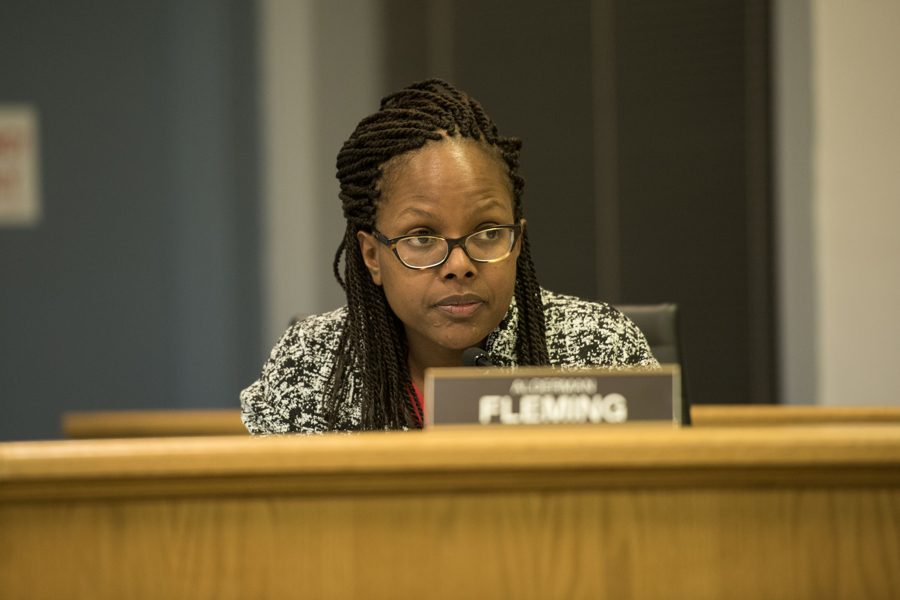District 65, community members take closer look at racial achievement gap
Katie Pach/Daily Senior Staffer
Ald. Cicely Fleming (9th) listens at city council. The achievement gap in District 65 widened in 2017 according to the Achievement and Accountability Report.
February 15, 2018
Henry Wilkins, a parent at Dr. Bessie Rhodes School of Global Studies, witnessed the impacts of the achievement gap as a black student growing up in Ohio. Thirty years later in Evanston, he’s not sure things have changed for his daughter.
In the past year, the gap between black student and white student achievement widened throughout Evanston/Skokie District 65 schools. According to the district’s 2017 Achievement and Accountability report released in January, test scores for black students from 2016 to 2017 fell more than those of white students on the Illinois Snapshot of Early Literacy and the Measure of Academic Progress, the district’s primary markers of academic success.
The achievement gap has long been an issue for parents in the district, who have pushed for more black teachers, a growing K-3 literacy program and improving programs for black kids for years.
Wilkins does not know if the gap has impacted his daughter’s education specifically, but said he was “disgusted” by the discrepancies in test scores across District 65. He said his main focus is always helping his daughter succeed in school.
“We try to do our best to make sure that we give her support to … put her in a position to excel,” Wilkins said.
During his time in office, District 65 superintendent Paul Goren said the district has made “a tremendous amount of progress” in closing racial gaps between suspensions between white students and students of color.
During his tenure, he said the district passed policies requiring the superintendent’s office to approve any suspensions over five days and implemented an extensive restorative justice program focusing on the rehabilitation of offenders through reconciliation with the community.
Academically, Goren said the district is still performing above state averages. In Evanston, however, Goren said black students are often behind their other classmates. He estimated that the gap is about three years’ worth of academic content and becomes evident around third grade.
In another attempt to close the gap, the board recently announced they will hire both a director of black student success and an equity instructional coach. However, Ald. Cicely Fleming (9th) said the district’s other attempts to close the gap have been unsuccessful.
At the meeting where the board announced the creation of the black student achievement director, District 65 parent and alum Tracy Fulce Gentle said her son went into District 65 in fifth grade at a seventh-grade math level and has since dropped back to grade level.
“Clearly something is wrong,” Fulce Gentle said. “Unfortunately, like me, my son has experienced firsthand how racism can impact student performance.”
Wilkins said the district’s decision to hire a director of black student success was the “easiest thing to do.” He wants to see the district consult with black residents in Evanston to come up with other solutions for the achievement gap.
Fleming said the gap became more apparent after the district started looking at test scores by race. She emphasized curricula often center on European and white history, which can make it difficult for black students to perform as well as white students.
“I don’t even really love calling it an achievement gap,” Fleming said. “You just look at student and value them based on a test score, (not) holistically what a student brings to the school environment, to the community.”
Fleming also highlighted the Foster School, an elementary school in the 5th Ward that closed in 1967. After the school closed, the “burden” to bus children outside of their neighborhood fell disproportionately on communities of color, Fleming said. Wilkins also noted the 5th Ward faces particular challenges. Opening up a school in the neighborhood may help, he said.
According to the Achievement and Accountability report, the gap negatively impacts students of color, students on free or reduced lunch and students with Individualized Education Programs for learning disabilities. In 2017, only 30.6 percent of black students met college readiness benchmarks for reading, compared to 83.7 percent of white students.
“We have to put a mirror on our practices,” Goren said. “Putting a mirror on our practices as it relates to race … will provide our educators and administrators with the opportunity to be reflective on data.”
Alex Morgan — board member for the Organization for Positive Action and Leadership, an Evanston grassroots organization focused on equity — said the gap is still an “urgent concern” in District 65.
“I’m not impressed,” Morgan said. “I don’t think there’s a single school in our district that should be content with their performance around the achievement gap.”
Email: catherinehenderson2021@u.northwestern.edu
Twitter: @caity_henderson



